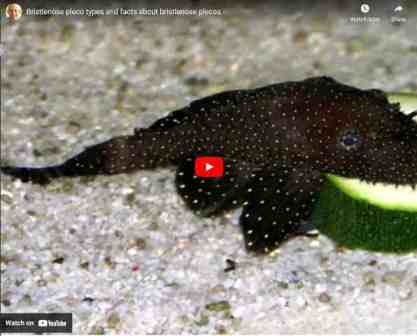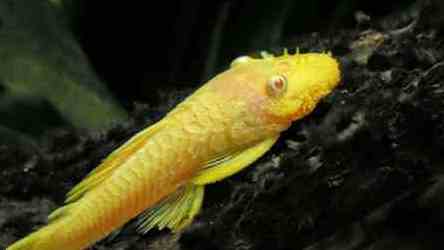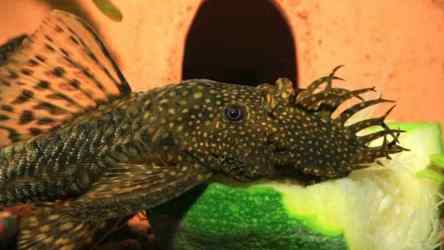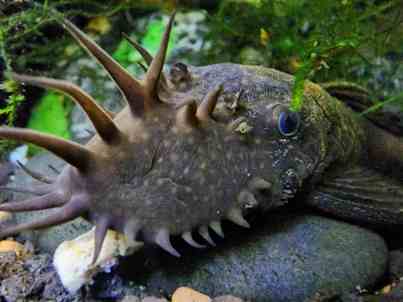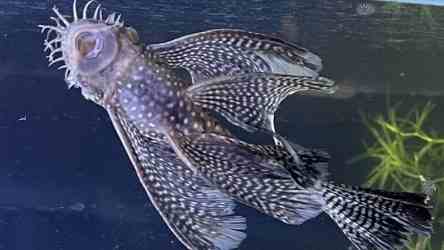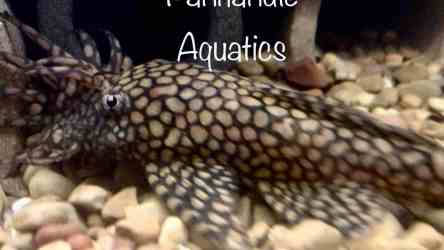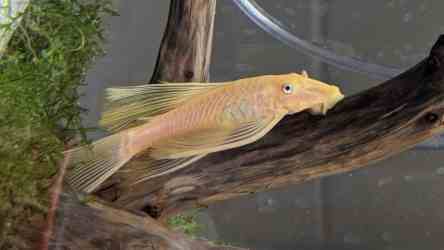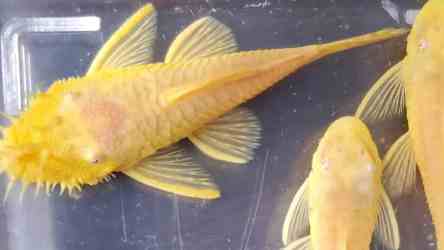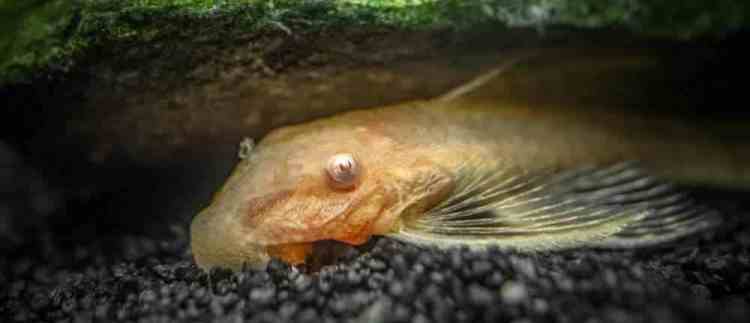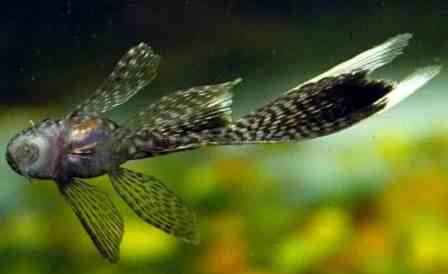Bristlenose / Bushynose Plecostomus Care – The Ultimate Guide…
1. Why put a Bristlenose Pleco in your Aquarium?
First, let’s start off with the fact that I have a female bristlenose plecostomus in my community tank. She is very shy but seems to always be healthy.
We can best describe bushynose plecos as alien, mysterious and unique.
They have a fascinating “tentacle” covered mouth (males), but there is more to this fish than just tentacles.
BP have been a favorite aquarium fish for a long time. This is probably because of their small size, their calm demeanor, and low maintenance requirements. Plus they are so weird looking.
Considering one as a pet? This article tells you what should know about this unique fish.
Important: I can tell you from first hand experience that Bristlenose Plecostomus are EASY to care for.
Video opens in a new window or tab:
2. Physical description
What is a Bristlenose Plecostomus?
They are members of the Loricariidae (catfish) family.
Biologists have classified them as armored catfish. Bony, hardened plates cover their bodies, resembling an exoskeleton (imagine Robocop). While the armor plates are visible on most of their bodies, they don’t have the armoring in the belly areas.
Distinctive to the species are their round mouth and long lips. Suckermouths are characteristics of all plecos, but BP’s stand out. Why? Well, they have bristles growing out of their nose. Duh.
Size and growth
They are a fish is rather small, at least in comparison with fellow plecos of the Loricariidae family. Their standard size is between 4-6 inches.
The one I have doesn’t like to be picked up and measured, but she (no bristles) is about 4.50″ long.
They appear fatter by size than other suckermouth catfish, because of their flattened bodies.

Bristlenose plecostomus image provided by adriansaquatics. Buy this fish by tapping here.
3. Bristlenose Plecostomus Lifespan
When kept in a clean tank with lots of water changes and good food they will live between ten and fifteen years.
 Tap above to view movie of the Calico Bristlenose. Look for the video in the photos section.
Tap above to view movie of the Calico Bristlenose. Look for the video in the photos section.
Movie provided by Aquatic Heavens
4. Types, varieties, or colors
What is a bristle nose pleco part 2.
You can look at the pictures I’ve posted below to see what types are available.
Many of the Plecos found by hobbyists are crossbreeds or hybrids.
Black
With a pitch-black base color, the light spotting on this variation stands out much more. Some Black Bristlenose Plecos display minimal marks and look almost entirely very dark to almost black.
Albino
As previously mentioned, the albinos of the species display a pale yellow coloration instead of white. They are also easily recognizable by their red eyes, a consequence of the lack of pigmentation.
Yellow with blue eyes
As the name shows, this species displays the same yellow coloration of the albino variation, yet the eyes have a blue shade. This is a consequence of “leucism”, meaning a partial loss of pigmentation rather than being true albinos.
Super Red
The Super Red coloration results from selectively breeding of albino variations of the species and yet Super Reds are actually closer to orange than red.
Green Dragon
As their name shows, this species displays a solid brownish-green coloration (see the image below). Their colors are lighter green when young, but darken as they grow older.
Longfin and Veiltail
Selective breeding has created variations with long, flowing fins. Longfin and Veiltail types can come up in any of the previously mentioned colorations.
Experience These Article in Audio Using Your Browser!
If a system or browser is not mentioned here, the I haven't been able to find out how to make the system or browser work to read aloud.
PC's: Using the Edge Browser, left click on the article text and scroll down to "Read Aloud." The article will automatically be read to you.
iPhone using the Edge Browser: Using the Edge brower, tap the icon that looks like a book with a speaker located in the in the address bar. The article will come up now showing 4 icons on top. Tap on the second icon from the right to have the article read to you.
Android phones: Google Assistant is the most convenient way. Say, "Google, read this page."
Bristlenose Plecostomus – Quick Start Guide
PDF Download
You can turn your aquarium fish hobby into an income producing side hustle.
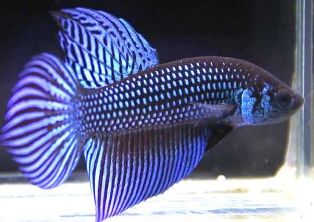
Create a website like mine to earn enough to buy aquariums, or fish, or equipment or if you work hard enough, retire from your 9 to 5.
I used "Divi" website creator to make this website. It costs $89/year (this comes out to about $7/month.)
Tap this ad to find out more.
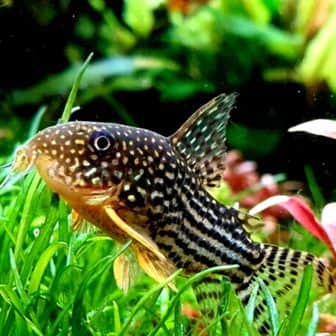
8 variations of bristlenose plecos:
Yellow Bristlenose Plecostomus
Tap image to view full size.
Tap here to view another awesome fish picture on this site (new window).
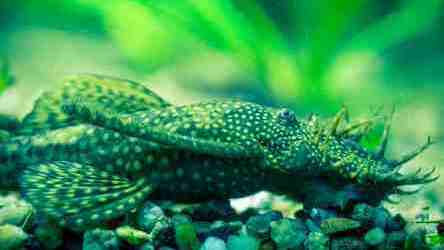
Greenish Color Bristlenose Plecostomus
Tap picture to view full size.
Tap to view another cool fish picture on this site (new window).
Common Brown Bristlenose Plecostomus
Tap picture to view full size.
Tap to view another cool fish picture on this site (new window).
Male Bristlenose Pleco
This amazing image provided by ATL Aquatics, an eBay store. Tap image to visit and view.
Longfin Bristlenose Plecostomus
Image provided by MaxxDon-5 an eBay seller. Tap image to price or buy.
Honeycomb Bristlenose Pleco
Image provided by Slime Moss 02 an eBay store. Buy this aweome pleco by tapping the image.
Long Fin Lemon Plecostomus
Image provided by chnel-5305, an eBay seller. To price or buy this pleco tap image.
Albino Bristlenose Plecostomus 1 male, 2 females
Image provided by Shoreline Aquatics, an eBay store. Tap image to see more plecos.
5. Habitat
BP’s are widespread across South America, especially found in the Amazon Basin.
They prefer fast-flowing rivers and floodplains and are found amidst heavy vegetation, driftwood, rocks, and other debris.
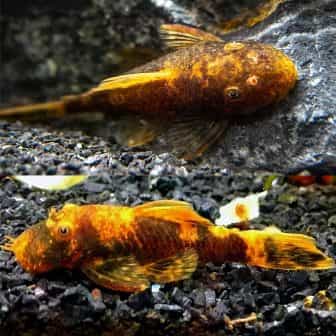
Calico colored Bristlenose pleco
Image provided by Aquatic Heavens, an Amazon seller. Visit, price, or buy by tapping the image.
6. Predators
Details about their predators are not well known.
The Bristlenose Pleco’s armor probably makes it difficult for predators to attack them in the wild.
Young Bristlenose Plecos dwell closer to the surface of brightly lit areas, therefore making them far more likely to be hunted by predators.
7. How to set up an aquarium for bristlenose / bushynose plecostomus fish
Sturdy and resistant, we know this species to be low-maintenance and an easy pick for newcomers to the aquarium hobby. However, the hobbyist shouldn’t confuse this simplicity with ease of care.
There are a few preferences Bristlenose Plecostomus fish have for their environment.
Aquarium size and characteristics:
As Bristlenose Plecos don’t grow large, large tanks are not required. One pleco would do well in a 30 gallon aquarium that is lightly stocked.
Personally, I would probably suggest a super lightly stocked 75 gallon aquarium and three plecos. The only issue I see with this set up is that with a mature male and female among the three, you’ll eventually have many dozens of pleco fry in the aquarium.
When it comes to water parameters, here is what you need to know:
Water temperature:
As tropical species, they should be kept in tanks with a stable temperature and minimal fluctuation, ideally between 73°F and 81°F (23-26°C).
pH:
This fish prefer slightly acidic water with a pH usually ranging between 6.0 and 7.5, though sometimes they can tolerate levels as low as 5.0, and as high as 7.8.
Water hardness:
As an Amazon River Basin fish, they prefer soft water.
Ammonia
Levels should always be at 0 ppm. It’s essential to keep the tank clean at all times since Bristlenose Plecos produce high levels of waste which could cause a lethal ammonia spike.
Filtration:
The previously-discussed high levels of fish waste, as well as their need for fast-flowing water, mean that you cannot keep a Bristlenose Pleco without a powerful filtration system for your tank.
Your goal should be to equip your aquarium with a system of at least 300 GpH, ideally a hanging or canister filter. Additionally, enhance the tank with appropriate air stones, water pumps, or air pumps to ensure healthy water flow.
Preferred substrates
Bristlenose Plecostomus are bottom-dwelling fish, so they enjoy interacting with the substrate in the search for food. While not particularly picky, it’s best if you enhance their enjoyment of the tank with a substrate that resembles their natural environment the most.
To achieve this, you should consider a rich substrate, like dirt or clay, topped with gravel. This choice will ensure your Pleco interacts with the bottom of the tank, while at the same time support the growth of plants.
And you will need plenty of plants.
Plants and decorations:
This catfish enjoy having a busy environment full of plants, driftwood and stone. The also like places where they can hide and find shelter like hollow driftwood or caves on behind sword plant leaves.
While it’s fine to use fake plants, it’d be much better for your tank to go for live ones. Regardless of the type, plants enhance your aquarium’s beauty and live plants oxygenize the environment to make it suitable for your plecos.
Lighting:
They are a nocturnal species, meaning it’s mostly active at night. Subsequently, they need plenty of hiding spots and shadowed spaces, as these fish naturally seek shelter from the light and rest during the day. This means they don’t require any specific lighting other than the minimum needed for your live plants.
Long fin albino pleco
8. What fish can you safely keep with your bristlenose pleco
Despite their alien-like appearance, Bristlenose Plecos are incredibly social and peaceful fish that thrive in community tanks.
Taking their serene nature into consideration, they are an ideal match for similarly-sized peaceful fish, like Angelfish, guppies, tetras, danios and barbs. The species rarely attacks other fish, but they are known to try and eat the slime coat of other fish if not properly fed.
However, there is one exception to their normally peaceful nature. The males of the species are often territorial and can engage in fights with other male plecos over food or the attention of females. Reducing the number of males in the aquarium solves this issue.
It’s also important to highlight the species’ nocturnal nature. Some aquarium owners believe the species is dull and inactive when in reality they are judging them on their day time behavior. Naturally, they display a more playful attitude during the night.
9. Feeding (diet)
In the wild,their diet consists mostly of algae and a biofilm-like substance named aufwuchs, which consists of algae, bacteria, microbes, and other protein-rich small animals that thrive on the surface of stones and wood.
Having raised plecos in the past the first “food” I would tell you to buy is a good sized piece of driftwood. My plecos constantly chewed on the wood in their aquarium.
I feed my Bristlenose protein based foods only right as I go to bed. I put in just enough to fill her stomach 1 and 1/2 times.
The foods I use included: API bottom feeder fish pellets with shrimp, Ulta fresh Tropical shrimp pie tablets, Fluval bug bites (dried insect larvae) formed into a mash wet ball, canned fresh mosquito larvae, frozen brine sprimp, and frozen blood worms.
In addition my pleco apprently eats ramshorn snails. I throw them in and they disappear shell and all. I know it’s not my Tiger Barbs eating them because the barbs leave the shell.
Chinese Algae Eater:
Because Your Tank Desperately Needs a Vacuum That Lives Forever and Hates Everyone
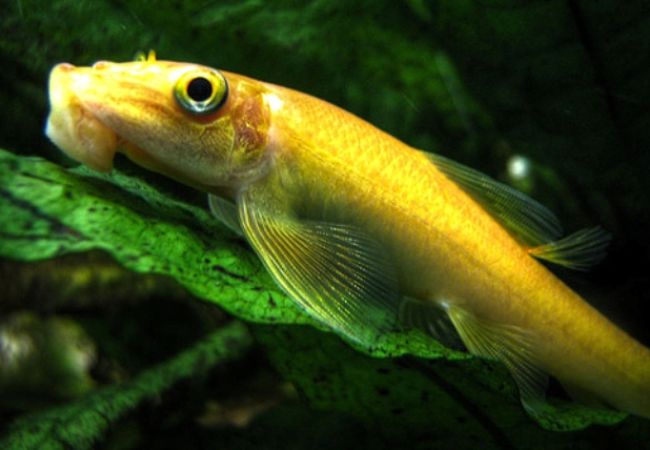
Categorys: Catfish, large fish
10. How you can tell the difference between males and females (gender)
It’s not easy to distinguish male and female Bristlenoses while young, but they develop full sexual clear characteristics once they reach full adulthood.
Males of the species display longer bristles, and they grow all over their heads. By contrast, females develop smaller tentacles, and they can only be found around their snout. Depending on the species, males may develop tentacles near the pectoral fin, though this isn’t common on Ancistrus.
11. How to breed bristlenose plecostomus fish
Bristlenose Plecos are one of the easiest egg laying species to breed, so odds are you won’t have to do much to ensure reproduction. Regardless, it’s essential to consider certain factors before starting your attempts.
Creating a mating pair
They’re not picky when it comes to choosing a mate, so it’s up to you to select the ideal match. You should always aim for young, healthy fish to ensure successful breeding and increase the survival odds of the offspring.
If you want to breed a particular color or appearance, you should consider genetic matches. For example, the albino characteristics are a recessive gene, so only matching two albino species can guarantee an identical progeny.
Breeding conditions and setup
Like plenty of other tropical fish, the Bristlenose Plecostomus reproduces during the rainy season of the Amazon River. Thus, in order to stimulate breeding, it’s suggested to set your aquarium’s temperature at least 7°F (4°C) degrees lower than the average. It’s best if you do 75% water changes.
Make sure your tank has plenty of secluded spots that are large enough to fit a mating pair. While purchasing caves is the optimal choice, you can always take the DIY route and include PVC pipes in your aquarium or a clay pot planter broken in half.
During mating season, males tend to be aggressive and fight amongst one another for territory with hiding spots, since they are essential for catching a female’s attention. To avoid these issues and ensure optimal mating conditions, it’s best if you keep the female-to-male ratio of 2:1.
The mating process
Males will select a hiding spot or cave to prepare for eventual spawning, cleaning the surface and making it eye-catching for the females.
Eventually, a female will pick the territory and enter to inspect it. If successful, the mating will start right away. Females will lay sticky orange eggs on top of the cave’s surface, and then males fertilize them.
Female Bristlenose Plecos leave the cave right after mating, and the males will then care for the eggs for the following five to ten days. They clean and aerate them with their fins regularly until they hatch.
Don’t worry if your female looks thinner after breeding, or if your male eats significantly less while caring for the eggs. These are the usual consequences of reproduction, and they will return to normal soon after.
Caring for the fry
If they’ve bred in a community tank, take out the fry as soon as they hatch. Fish, regardless of behavior, enjoy eating the newborns.
The eggs of this type of pleco take between five to ten days to hatch and an additional five days to swim freely.
Fry prefer to eat algae, but you can supplement with powdered spirulina or mashed peas before moving on to bigger meals.
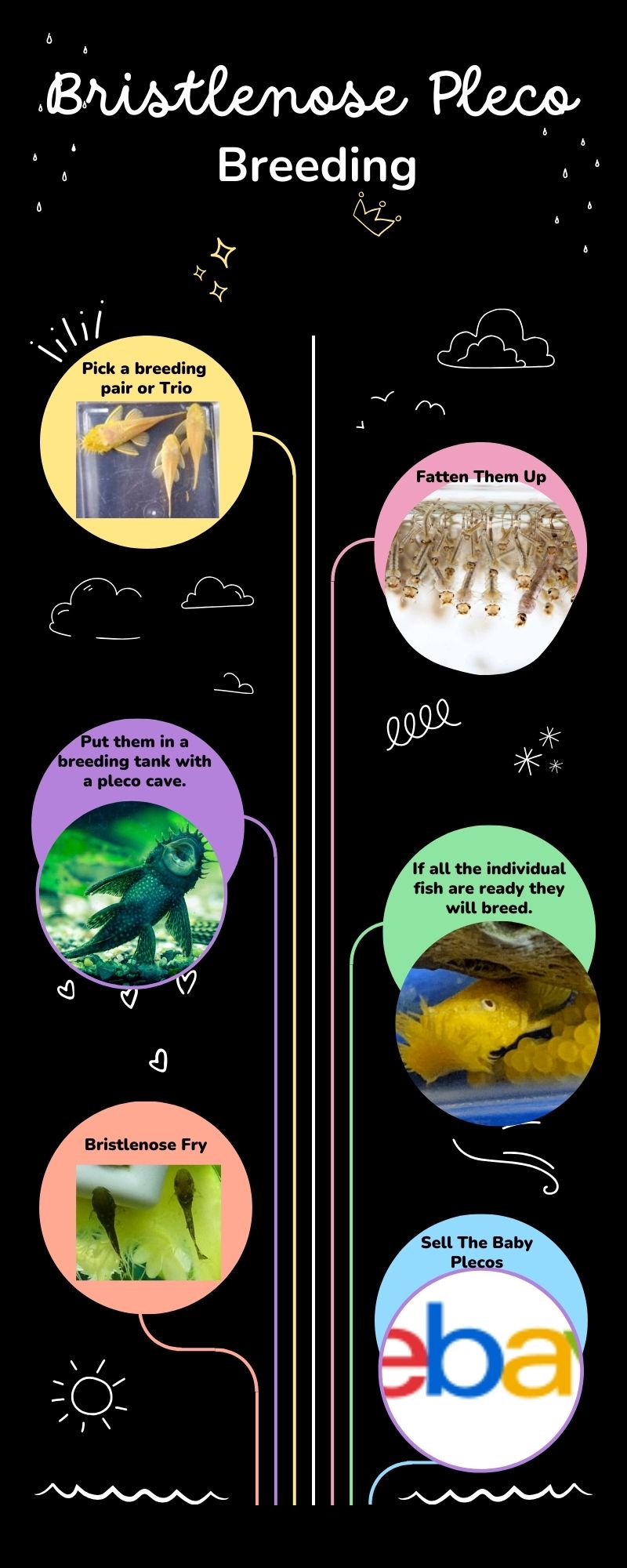
12. Diseases
What are common diseases of the Bristlenose Plecostomus?
It turns out Plecos are as hardy as they look. The species is not known to be prone to any disease, and their sturdy health makes it very unlikely for any of them to fall sick.
That is if the tank conditions are always optimal.
Chemical imbalances in the water can cause ammonia spikes, subsequently making your fish susceptible to opportunistic bacterial infections. These can cause localized damage in some of their body parts, including their distinctive barbells. Also a lack of proper oxygenation or water flow in the tank can affect your Bristlenose’s general health.
Signs of potential illness or poor water conditions are reduced appetite, eating during daytime, dull coloration, and swimming upwards in the tank. Most of the time, potential afflictions can be prevented by frequent, large water changes.
Conclusion
Peaceful, friendly, and funny-looking, Bristlenose Plecos are an original addition to liven up any aquarium.
Community aquariums of fellow calm fish are ideal for the Bristlenose Plecostomus, not to mention they are an excellent way to keep your algae levels under control.
In general lines, they are a perfect starter fish for anyone trying to get a head start in the aquarium hobby and a staple choice for long-time experts that can appreciate their uniqueness and charm.
Additional Information
U.S. Fish and Wildlife Service (.gov) – Jumbie Tetra (Ancistrus cirrhosus) PDF
Bifi, Alessandro & Pavanelli, C. & Zawadzki, Cláudio. (2009). Three New Species Of Ancistrus Kner, 1854 (Siluriformes: Loricariidae) From The Rio Iguaçu Basin, Paraná State, Brazil. Zootaxa. 2275. 41-59. 10.5281/zenodo.191064. Dense university science paper
Ancistrus cirrhosus (Valenciennes, 1836) GBIF | Global Biodiversity Information Facility
Planet Catfish – Common Bristlenose Catfish
Online Journal of Science and Technology – Breeding Bristlenose Plecostomus (PDF)
Best Fish For Beginners
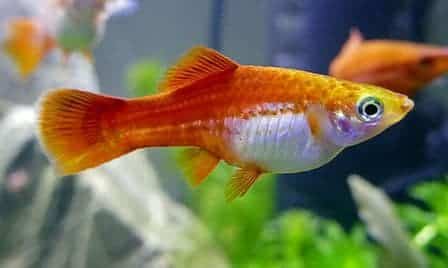
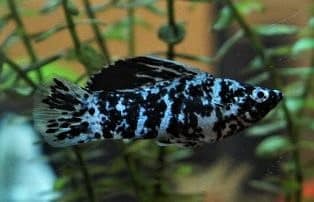
Categories: small fish, beginner fish, easy fish
